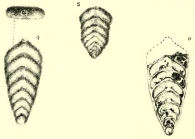Foraminifera taxon details
Howchinella Palmieri, 1985 †
721378 (urn:lsid:marinespecies.org:taxname:721378)
accepted
Genus
Frondicularia woodwardi Howchin, 1895 † accepted as Howchinella woodwardi (Howchin, 1895) † (type by original designation)
- Species Howchinella aulax (Crespin, 1958) †
- Species Howchinella complanata Zhang & Gu, 2015 †
- Species Howchinella composita Karavaeva & Nestell, 2007 †
- Species Howchinella costata Palmieri, 1994 †
- Species Howchinella costulata Karavaeva & Nestell, 2007 †
- Species Howchinella deplanata Karavaeva & Nestell, 2007 †
- Species Howchinella dilatata Karavaeva & Nestell, 2007 †
- Species Howchinella elongata Karavaeva & Nestell, 2007 †
- Species Howchinella glandiformis Karavaeva & Nestell, 2007 †
- Species Howchinella hubeiensis Zhang & Gu, 2015 †
- Species Howchinella humilicamerata Filimonova, 2015 †
- Species Howchinella incisa Palmieri, 1994 †
- Species Howchinella inflata Zhang & Gu, 2015 †
- Species Howchinella linguaeformis Karavaeva & Nestell, 2007 †
- Species Howchinella mantuanensis Palmieri, 1994 †
- Species Howchinella plana Karavaeva & Nestell, 2007 †
- Species Howchinella pseudojacutica Karavaeva & Nestell, 2007 †
- Species Howchinella rigida Palmieri, 1994 †
- Species Howchinella rulonica Filimonova, 2015 †
- Species Howchinella woodwardi (Howchin, 1895) †
- Species Howchinella xiangxiensis Zhang & Gu, 2015 †
marine, brackish, fresh, terrestrial
fossil only
feminine
Palmieri, V. (1985). Plant microfossils, Foraminiferida, and Ostracoda, from the Fossil Cliff Formation (Early Permian, Sakmarian), Perth Basin, Western Australia. 2. Foraminiferida. <em>South Australia Department of Mines and Energy Special Publication.</em> 5: 79-95., available online at https://sarigbasis.pir.sa.gov.au/WebtopEw/ws/samref/sarig1/image/DDD/SP005.pdf
page(s): p. 83 [details] Available for editors [request]
[request]
page(s): p. 83 [details] Available for editors
Diagnosis Test elongate and flattened with longitudinal central depression, tapering at the base, uniserial equitant chambers...
Diagnosis Test elongate and flattened with longitudinal central depression, tapering at the base, uniserial equitant chambers increasing rapidly in breadth in the early stage, then very slowly so that lateral margins are nearly parallel, sutures chevron shaped, early ones flush, later weakly depressed, periphery rounded; wall calcareous, with dark thin inner organic layer and outer hyaline layer of optically radial calcite, secondarily nonlamellar (atelomonolamellar) or partially lamellar (plesiomonolamellar); aperture terminal, radiate, slightly produced. L. Permian (Sakmarian); Western Australia. (Loeblich & Tappan, 1987, Foraminiferal Genera and Their Classification) [details]
Hayward, B.W.; Le Coze, F.; Vachard, D.; Gross, O. (2025). World Foraminifera Database. Howchinella Palmieri, 1985 †. Accessed at: https://www.marinespecies.org/Foraminifera/aphia.php?p=taxdetails&id=721378 on 2025-05-26
Date
action
by
original description
Palmieri, V. (1985). Plant microfossils, Foraminiferida, and Ostracoda, from the Fossil Cliff Formation (Early Permian, Sakmarian), Perth Basin, Western Australia. 2. Foraminiferida. <em>South Australia Department of Mines and Energy Special Publication.</em> 5: 79-95., available online at https://sarigbasis.pir.sa.gov.au/WebtopEw/ws/samref/sarig1/image/DDD/SP005.pdf
page(s): p. 83 [details] Available for editors [request]
[request]
basis of record Loeblich, A. R.; Tappan, H. (1987). Foraminiferal Genera and their Classification. Van Nostrand Reinhold Company, New York. 970pp., available online at https://books.google.pt/books?id=n_BqCQAAQBAJ [details] Available for editors [request]
[request]
page(s): p. 83 [details] Available for editors
basis of record Loeblich, A. R.; Tappan, H. (1987). Foraminiferal Genera and their Classification. Van Nostrand Reinhold Company, New York. 970pp., available online at https://books.google.pt/books?id=n_BqCQAAQBAJ [details] Available for editors
From editor or global species database
Diagnosis Test elongate and flattened with longitudinal central depression, tapering at the base, uniserial equitant chambers increasing rapidly in breadth in the early stage, then very slowly so that lateral margins are nearly parallel, sutures chevron shaped, early ones flush, later weakly depressed, periphery rounded; wall calcareous, with dark thin inner organic layer and outer hyaline layer of optically radial calcite, secondarily nonlamellar (atelomonolamellar) or partially lamellar (plesiomonolamellar); aperture terminal, radiate, slightly produced. L. Permian (Sakmarian); Western Australia. (Loeblich & Tappan, 1987, Foraminiferal Genera and Their Classification) [details]
From editor or global species database
Image from typetaxon

